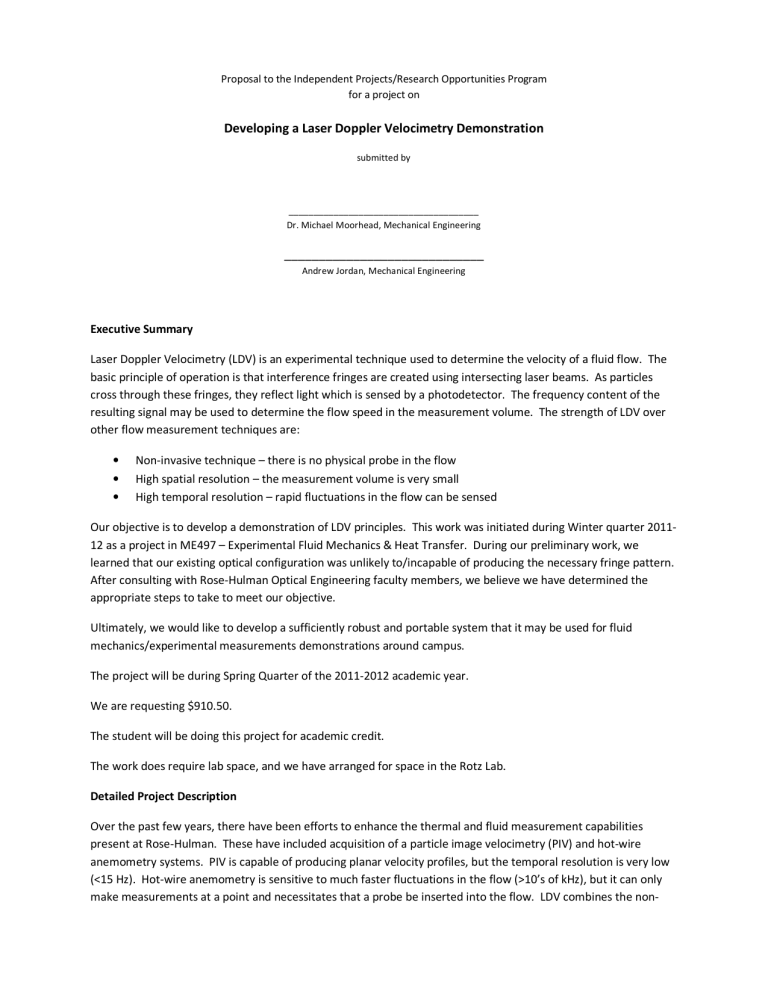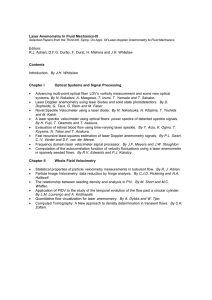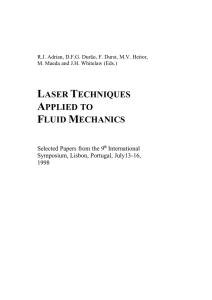Developing a Laser Doppler Velocimetry Demonstration _____________________________ for a project on

Proposal to the Independent Projects/Research Opportunities Program for a project on
Developing a Laser Doppler Velocimetry Demonstration
submitted by
______________________________________
Dr. Michael Moorhead, Mechanical Engineering
_____________________________
Andrew Jordan, Mechanical Engineering
Executive Summary
Laser Doppler Velocimetry (LDV) is an experimental technique used to determine the velocity of a fluid flow. The basic principle of operation is that interference fringes are created using intersecting laser beams. As particles cross through these fringes, they reflect light which is sensed by a photodetector. The frequency content of the resulting signal may be used to determine the flow speed in the measurement volume. The strength of LDV over other flow measurement techniques are:
•
Non-invasive technique – there is no physical probe in the flow
•
High spatial resolution – the measurement volume is very small
•
High temporal resolution – rapid fluctuations in the flow can be sensed
Our objective is to develop a demonstration of LDV principles. This work was initiated during Winter quarter 2011-
12 as a project in ME497 – Experimental Fluid Mechanics & Heat Transfer. During our preliminary work, we learned that our existing optical configuration was unlikely to/incapable of producing the necessary fringe pattern.
After consulting with Rose-Hulman Optical Engineering faculty members, we believe we have determined the appropriate steps to take to meet our objective.
Ultimately, we would like to develop a sufficiently robust and portable system that it may be used for fluid mechanics/experimental measurements demonstrations around campus.
The project will be during Spring Quarter of the 2011-2012 academic year.
We are requesting $910.50.
The student will be doing this project for academic credit.
The work does require lab space, and we have arranged for space in the Rotz Lab.
Detailed Project Description
Over the past few years, there have been efforts to enhance the thermal and fluid measurement capabilities present at Rose-Hulman. These have included acquisition of a particle image velocimetry (PIV) and hot-wire anemometry systems. PIV is capable of producing planar velocity profiles, but the temporal resolution is very low
(<15 Hz). Hot-wire anemometry is sensitive to much faster fluctuations in the flow (>10’s of kHz), but it can only make measurements at a point and necessitates that a probe be inserted into the flow. LDV combines the non-
invasive nature of PIV with the temporal characteristics of hot-wire anemometers, with the downside that it still produces point measurements.
LDV utilizes interference fringes created by two intersecting laser beams, as shown in Figure 1.
Figure 1: Close-up of LDV fringes
During our preliminary work, a fiber-coupled beam splitter was used to create these two beams from a single laser.
While our system was able to sense particles reflecting light, the expected fringes were not present. After consulting with Optical Engineering faculty members, it was determined that the interference fringes are extremely sensitive to the motion of the fiber optics. It was hypothesized that the fringes were present, but moving about in an unpredictable manner. The current proposal is to continue using a fiber-coupled system (for portability and flexible setup) but to split the two beams after they exit the fiber using a beamsplitter and mirror.
Although some of these individual items may be available on a temporary basis from the Optical Engineering department, we want to construct a standalone system that can be used as a demonstrator for future use.
With this project, the student will further advance his knowledge of optical principles and their application to
Mechanical Engineering experimentation. He will also use this system to better understand how flow velocities are affected by objects in the flow, and how such interactions can affect experimental results.
Budget
A large majority of the components needed to build a reliable LDV system are already in possession of the
Mechanical Engineering department. However, in order to construct an accurate system that can be transported around campus and used in many applications, some new components would be needed.
Equipment
Laser to Fiber Coupler
Shielded Fiber Cable
Collimator
Alignment Kit for Fibers
Beamsplitter
Protected Silver Mirror
2 Adjustable Mirror Mounts
Supplies/Consumables
None Required
Total Request
$221.20
$134.50
$185.00
$135.00
$104.00
$51.00
$39.90 each
$910.50




